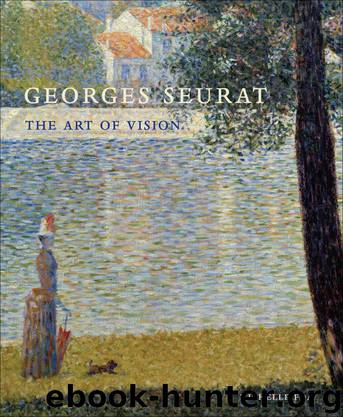Wiley Series 7 Exam Review 2015 + Test Bank by The Securities Institute Of America & Inc

Author:The Securities Institute Of America & Inc.
Language: eng
Format: azw3
Tags: Business & Finance, Finance, Finance & Investing
ISBN: 9781118856796
Publisher: Wiley
Published: 2014-11-01T00:00:00+00:00
FIGURE 85 Multiple proscenium arches in Richard Wagner’s Festspielhaus, Bayreuth, Germany. National Archives of the Richard-Wagner-Foundation, Bayreuth.
It is productive, I would argue, to see Seurat’s comparison of his dark borders and frames to the darkness of the Bayreuth auditorium as indicative of his thinking not only about the edges of his pictures, but also about particular paradigms of painting and different kinds of visual experience more broadly. Indeed, for centuries, picture frames had been discussed in terms of holding and directing the gaze of the viewer; Seurat had no need to cite Wagner’s theater simply to describe this aspect of the function of frames.17 Accordingly, Seurat’s reference to Wagner should be understood as evoking a much larger but also more specific set of issues with regard to his frames and borders. For one, given that his dark frames enclosed paintings of performers and audiences, it seems that Seurat was proposing a partial analogy between the effects that his paintings might have on his viewers, the effects of the spectacles that he was depicting on their spectators, and those of Wagner’s operas on their audiences.18 Although Wagner would no doubt have objected to this aligning of his operas with these popular entertainments, both kinds of performances were commonly discussed as inducing a sense of disorientation and hypnotization. Furthermore, both the darkening of Wagner’s theater and Seurat’s frames and borders were aimed, in part, at creating spatial illusions. Thus, Seurat perhaps saw his framing devices—the painted frame or the interior painted border that it encloses—as analogous to the double proscenium at Bayreuth, which was also intended to have a repoussoir effect and create a sense of spatial recession.19 In his essay titled “Bayreuth,” Wagner described the intended purpose of the proscenium as creating “the singular illusion of an apparent throwing back of the scene itself, making the spectator imagine that it is quite far away, though he still beholds it in all the clearness of its actual proximity.” In both the Bayreuth theater and in Parade, spatial ambiguities of scale, proximity, and distance reign, undermining our ability to make cognitive sense of what our senses perceive. For Helmholtz, phantasmagoria were those sensory experiences to which we are unable to ascribe specific external causes or sources. It is thus no coincidence that performances of Wagner’s operas were also characterized as phantasmagorical, most famously by Adorno, precisely because of the concealment of the means by which the various sounds, sights, and illusions were produced.20 Vision, here, is not a means of gathering knowledge about the exterior world, of deciphering one’s surroundings and one’s place in them, but, instead, is a mechanism for becoming entranced by and disoriented within this world, pleasurably taking in the “optical phantasmagoria” around one. As one commentator described itinerant fair amusements in Hugues Le Roux’s major 1889 book on circus and fairground performances (a passage that appears just one page after an illustration of the parade of the Cirque Corvi, no less): “It is only in mystery that our pleasure lies.
Download
This site does not store any files on its server. We only index and link to content provided by other sites. Please contact the content providers to delete copyright contents if any and email us, we'll remove relevant links or contents immediately.
The Black Swan by Nassim Nicholas Taleb(7055)
Bad Blood by John Carreyrou(6581)
Pioneering Portfolio Management by David F. Swensen(6253)
Millionaire: The Philanderer, Gambler, and Duelist Who Invented Modern Finance by Janet Gleeson(4420)
Skin in the Game by Nassim Nicholas Taleb(4201)
Bullshit Jobs by David Graeber(4138)
The Money Culture by Michael Lewis(4132)
Skin in the Game: Hidden Asymmetries in Daily Life by Nassim Nicholas Taleb(3960)
The Wisdom of Finance by Mihir Desai(3693)
Blockchain Basics by Daniel Drescher(3540)
Liar's Poker by Michael Lewis(3413)
Fooled by Randomness: The Hidden Role of Chance in Life and in the Markets by Nassim Nicholas Taleb(3080)
Hands-On Machine Learning for Algorithmic Trading by Stefan Jansen(3042)
The Intelligent Investor by Benjamin Graham Jason Zweig(3010)
Mastering Bitcoin: Programming the Open Blockchain by Andreas M. Antonopoulos(3010)
The Power of Broke by Daymond John(2932)
Investing For Dummies by Eric Tyson(2920)
Market Wizards by Jack D. Schwager(2669)
Zero Hour by Harry S. Dent Jr. & Andrew Pancholi(2628)
